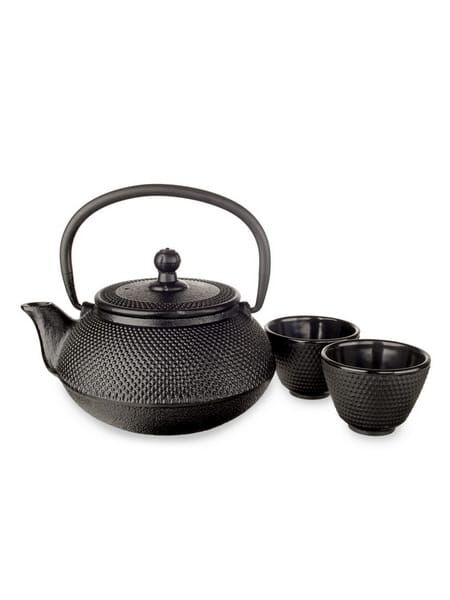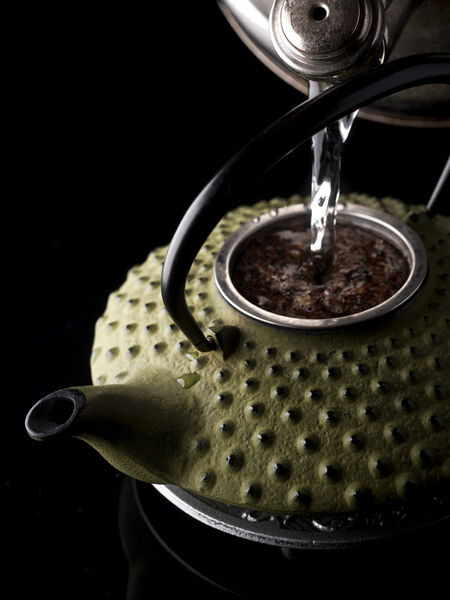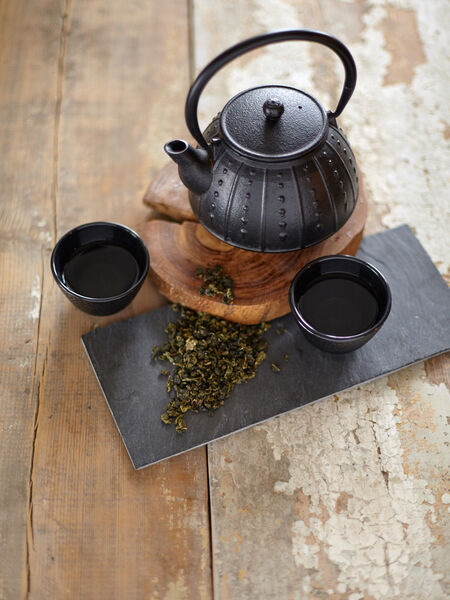Japanese Tetsubin



They were used not to brew matcha, but the small luxurious green tea leaves of sencha that were first introduced to Japan from China during the mid-17th century and first associated, like many teas, with medicinal purposes. Sencha drinking was favored by the ruling class in Japan, particularly the literati, but by the 18th century, sencha was part of everyday tea drinking with friends and family throughout Japan just as it is today.
How Tetsubin Reached the Masses
The popularity of sencha brought with it the dilemma of finding affordable teapots and kettles. Through an evolution that ran the gamut from sake warmers to copper pots the tetsubin was developed because iron was determined to offer the best tasting boiled water for tea. This new cast-iron teapot was used to heat water, brew sencha and, often, to heat the room or add humidity, in lieu of an open hearth, during the early part of the 18th century.
The tetsubin became hugely popular, and every strata of society had its version of cast-iron kettles: kitchen kettles, rural kettles, standard kettles and ornamental kettles. The urge to decorate kettles into pure objects of beauty was such that by the early 19th century the designs not only reflected the aesthetic of Japanese art, they became a symbol of the status, wealth and position in society achieved by its users, no small irony for a kettle that first began as a revolt against elitists.
The designs of the ornamental pots were often, and still are, cherry blossoms, the national flower of Japan; dragonflies, which symbolize new beginnings or good fortune, or other elements of nature that artisans can conjure. Some pots of round knobs all over it as they're referred to as "hobnail" pots not unlike hobnail glass accessories.
Tetsubin used in Chanoyu
Tetsubins, since their introduction, became a part of chanoyu and particularly important for students learning the ceremony. Students first practice this art in a very simple ceremony called ryakuban which uses very little equipment and generally involves techniques for heating water for tea.
Whenever chanoyu is conducted outdoors, a tetsubin is used because it is obviously portable and easy to carry instead of the heavy iron kettle (chagama or ortegama) which has no spout or handle and uses a ladle to scoop out hot water for tea. During kaiseki, in which a light meal is served before the actual chanoyu, the tetsubin is used.
The decorations on tetsubin pots are displayed to great effect during chanoyu when the host serves tea by holding the pot with his left hand with the spout facing the right. (Serving tea with your right hand holding the pot and the spout to the left is perfectly okay for that was how sencha was originally served, another rebellious gesture against what was perceived as the elitist chanoyu.)
Guidelines for Purchasing a Tetsubin
Today's tetsubins come in a wide variety of sizes from eight ounces to thirty-four ounces or larger. Look for ones that are hand-painted and hand-made, versus the cheaper machine-made ones. You'll not only have a better pot, you'll avoid the dilemma of faulty workmanship where paint chips, enamel peels or the interior rusts or oxidizes because of poor glazing.
The finest tetsubins are tremendously labor intensive to make, up to forty known steps, and black remains the classic color although red, green, beige and blue tetsubins are available. Pots come with either enamel coating on the exterior or none. Uncoated pots allow more iron to infuse the water, along with the tea, and some enthusiasts believe this enhances the flavor of the tea. Enameled pots are perfectly fine and not only resist rusting; they have zero impact on the flavor of the tea.
The tetsubin should feel heavy and using two hands to use it is not unexpected. A pot that is too light a weight indicates a cheaply made pot (often including clay!) that will not keep the tea as hot as a traditional pot will. If you're considering larger pot (more than thirty ounces), make sure it is not too heavy for you to handle comfortably because the pot will be even heavier when the water is added.
Color, shape, ornamental design and size are all personal choices to consider, as is the price. The better the pot, the higher the price. A realistic price range for a well-made pot ranges from $50 to $200 and is a very sound investment which will last for generations.
How to Use
Although you can certainly brew tea directly in a tetsubin, and pour the tea through a hand-held strainer, it is imperative that the tea be poured out completely into another pot; otherwise the tea will get bitter. It is easier to use a stainless steel, fine-meshed sieve that you can easily withdraw from the pot with tongs after the initial brewing. This not only prevents the leaves from lingering in the pot and making the tea liquor bitter, it is infinitely easier to clean up afterward.
While sencha is still a popular choice for these pots, the type of tea can be anything from sencha to hojicha, bancha, genmaicha, or any other tea of your choice. Because the interior is glazed or enameled, it is not necessary to dedicate the pot to one type of tea. The tetsubin can also be used to hold only water should you want to use a porcelain or clay pot for the actual brewing. Its heavy cast-iron will keep the water hot for at least an hour. Do not put a tetsubin on a flame or electric stovetop; it can damage the pot, make it unbearably hot to handle, and in the case of glass-top electric stoves, could crack the glass.
After each use, rinse with water only and thoroughly dry the outside and inside to avoid rust, especially if the interior is not enameled. Its indestructible iron material means it will last for generations to come with this simple two-step rinsing and drying technique.
 teaclass
teaclass
